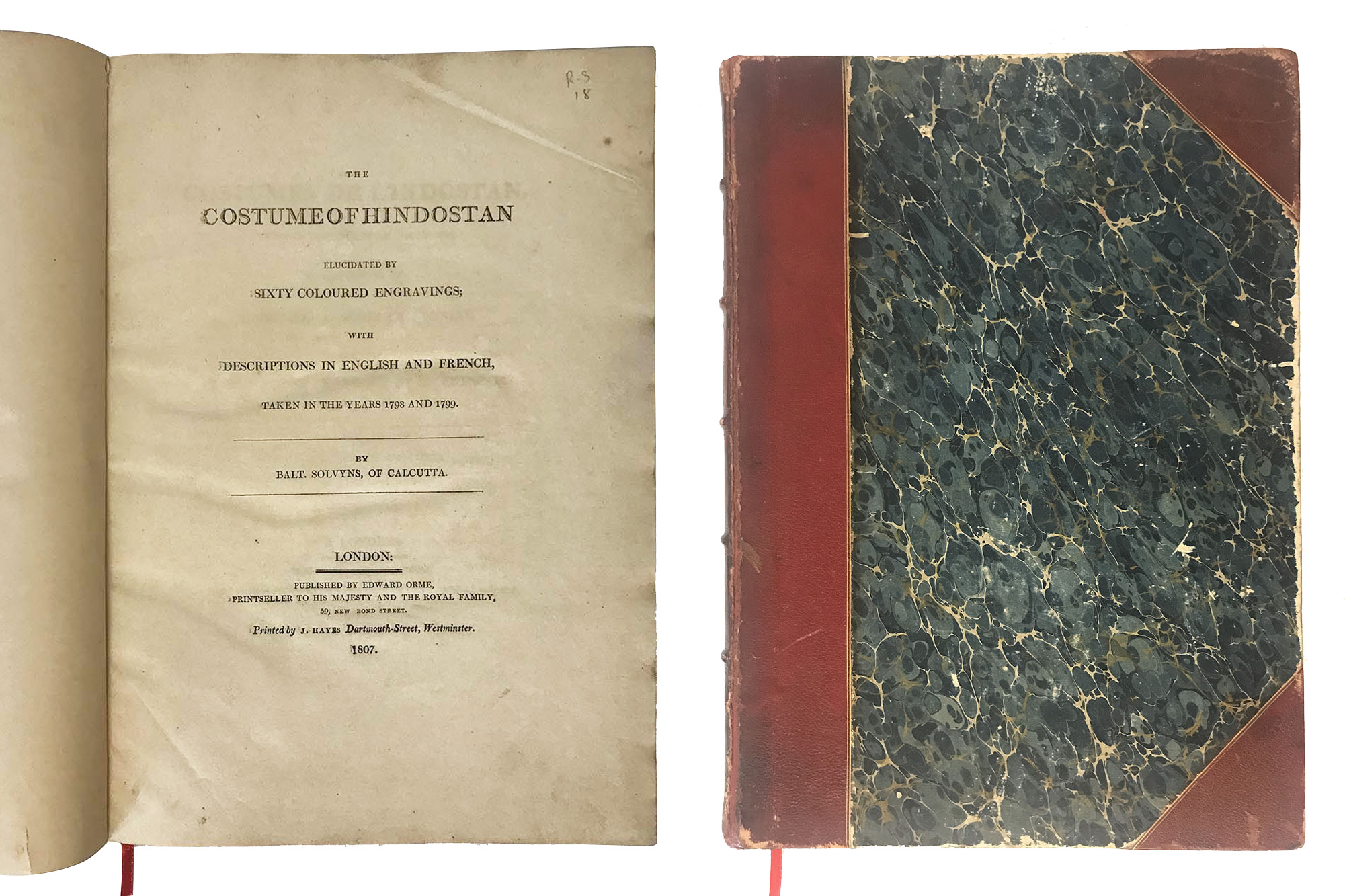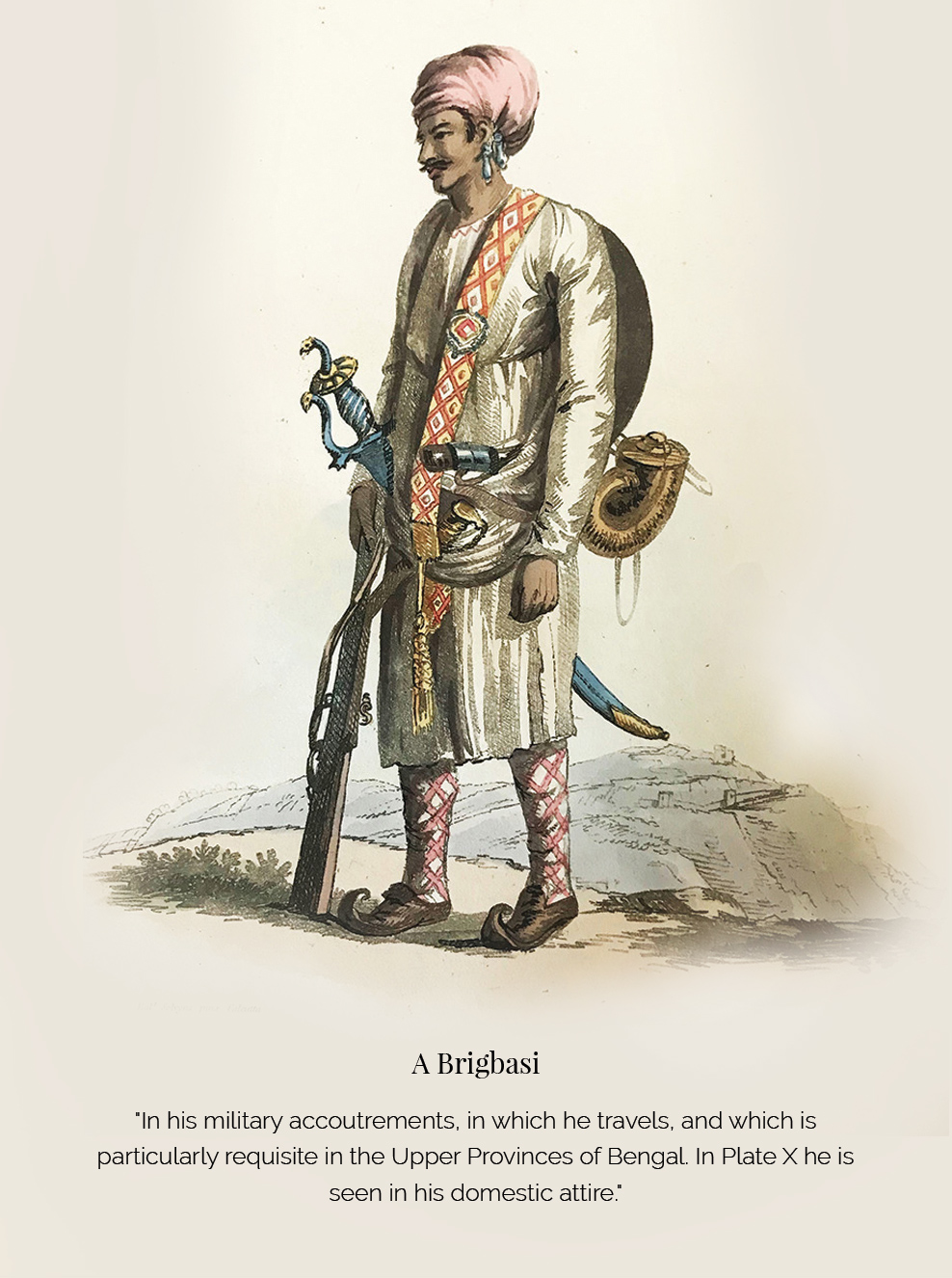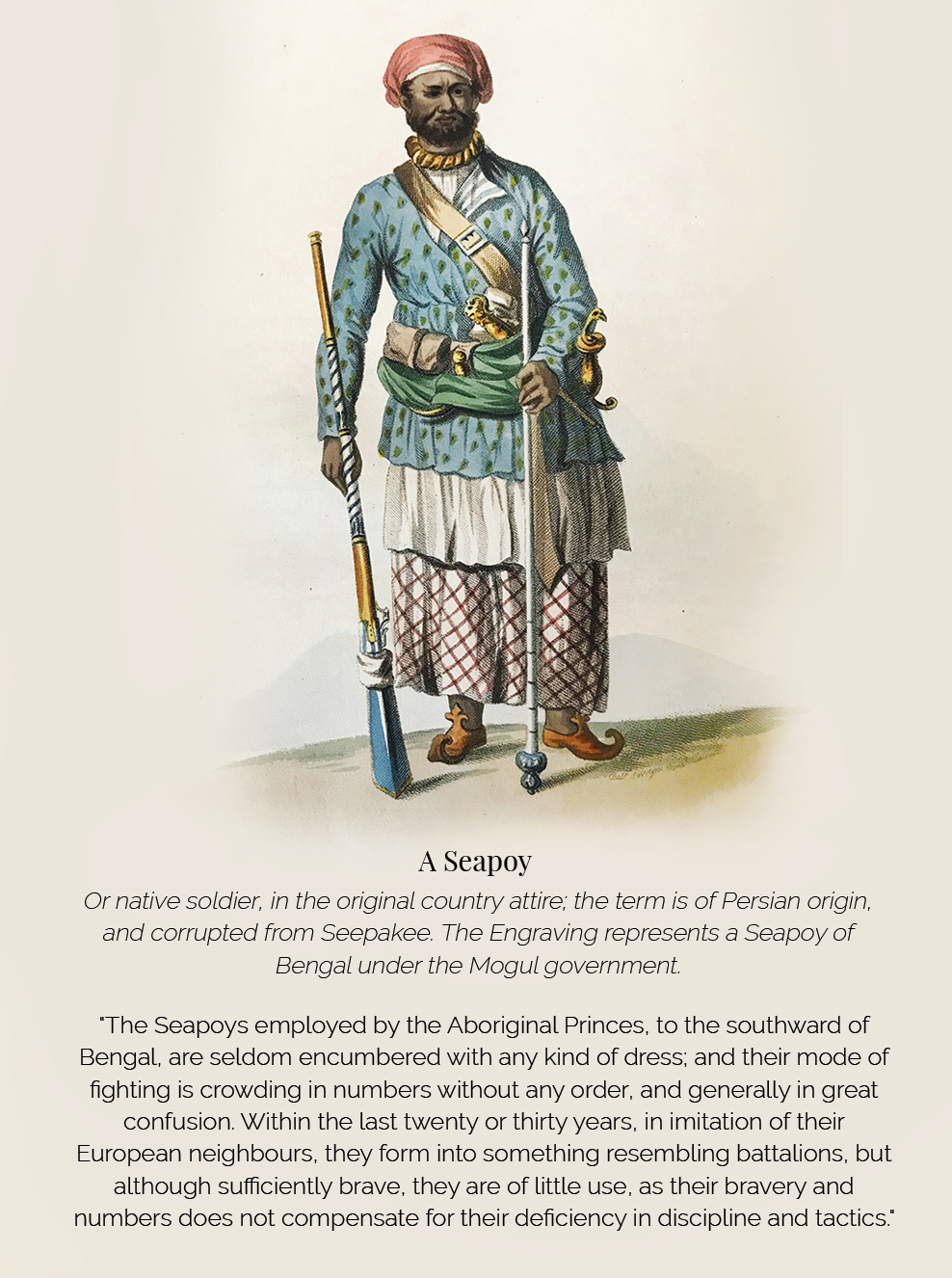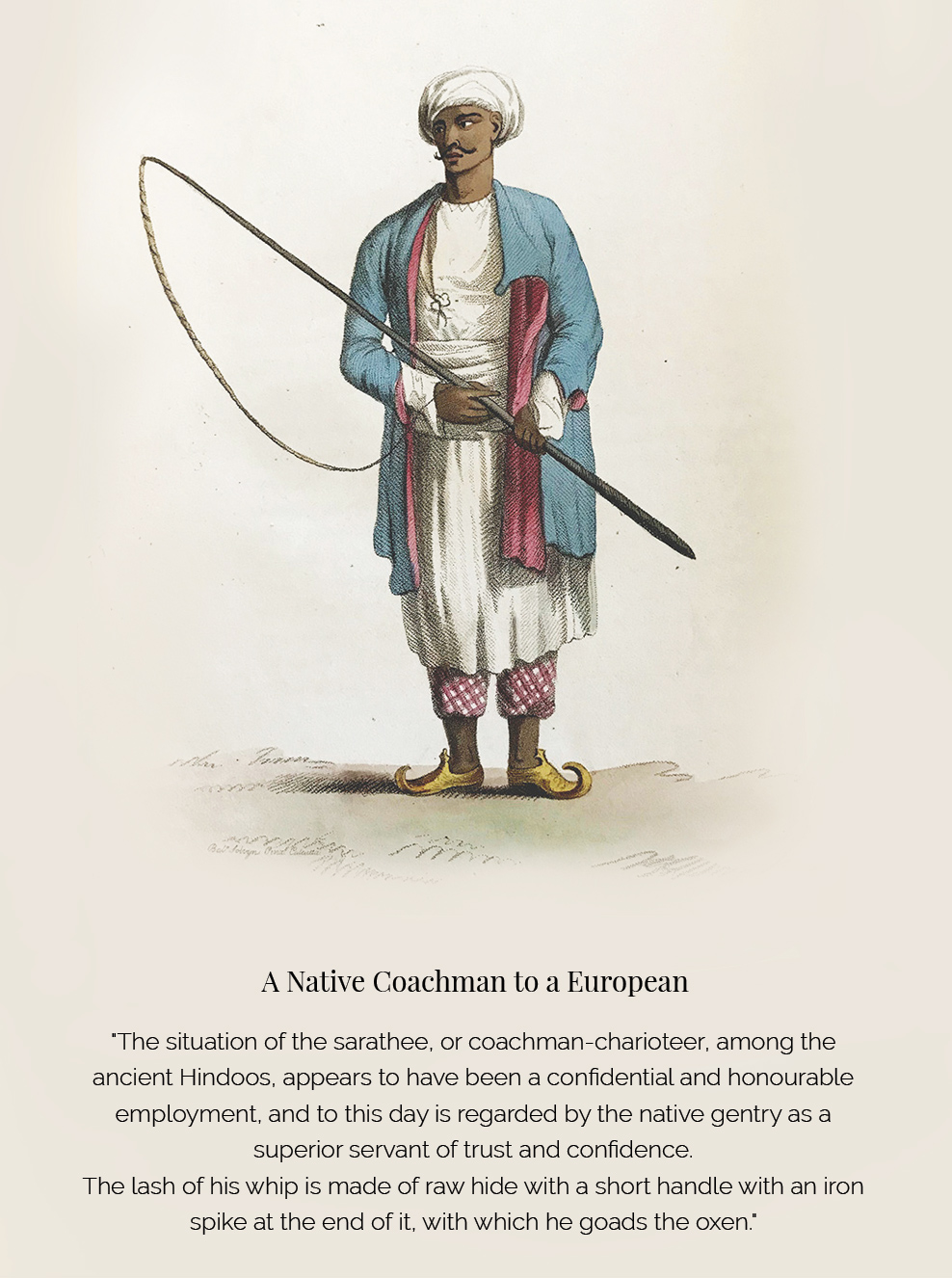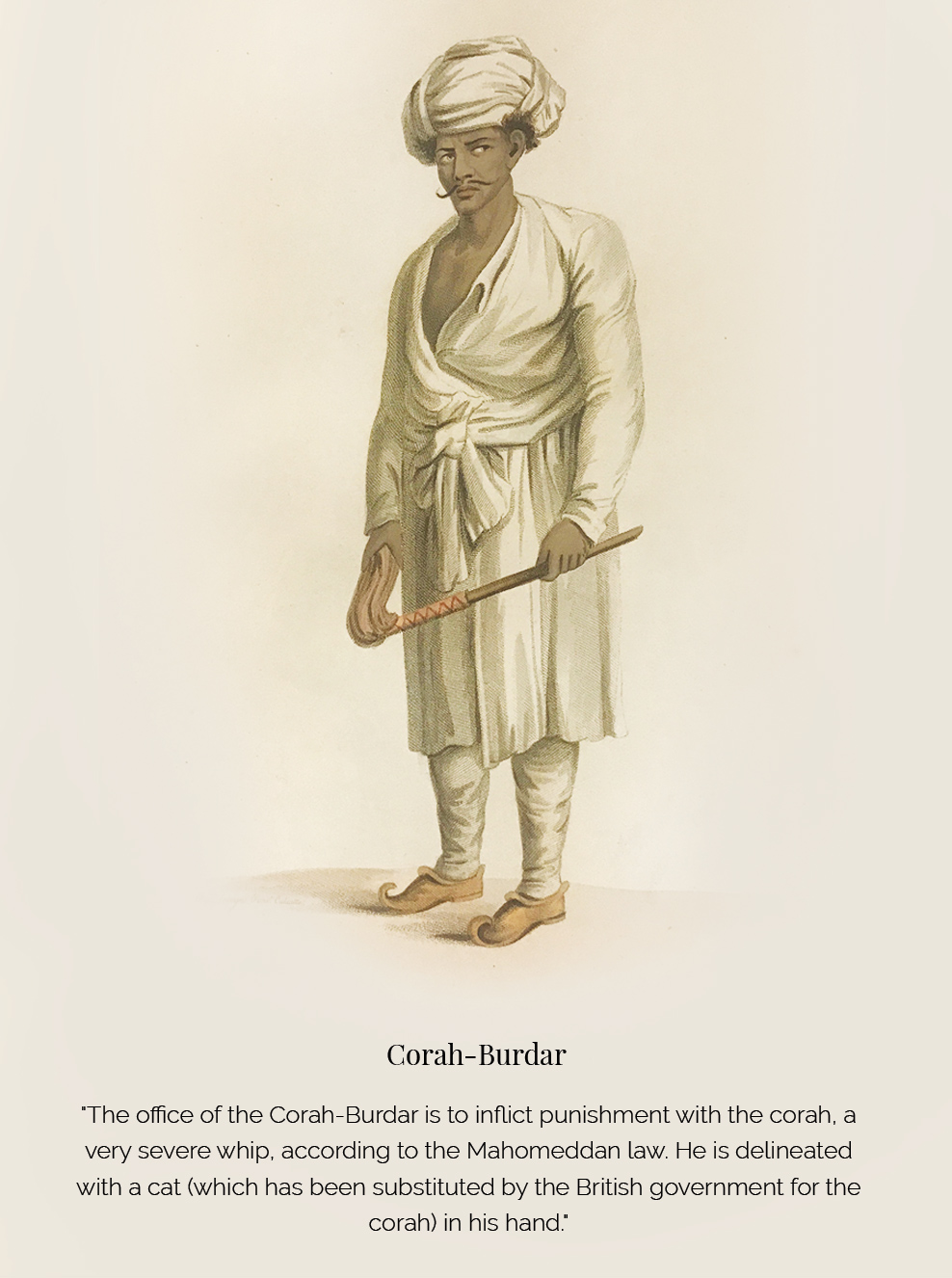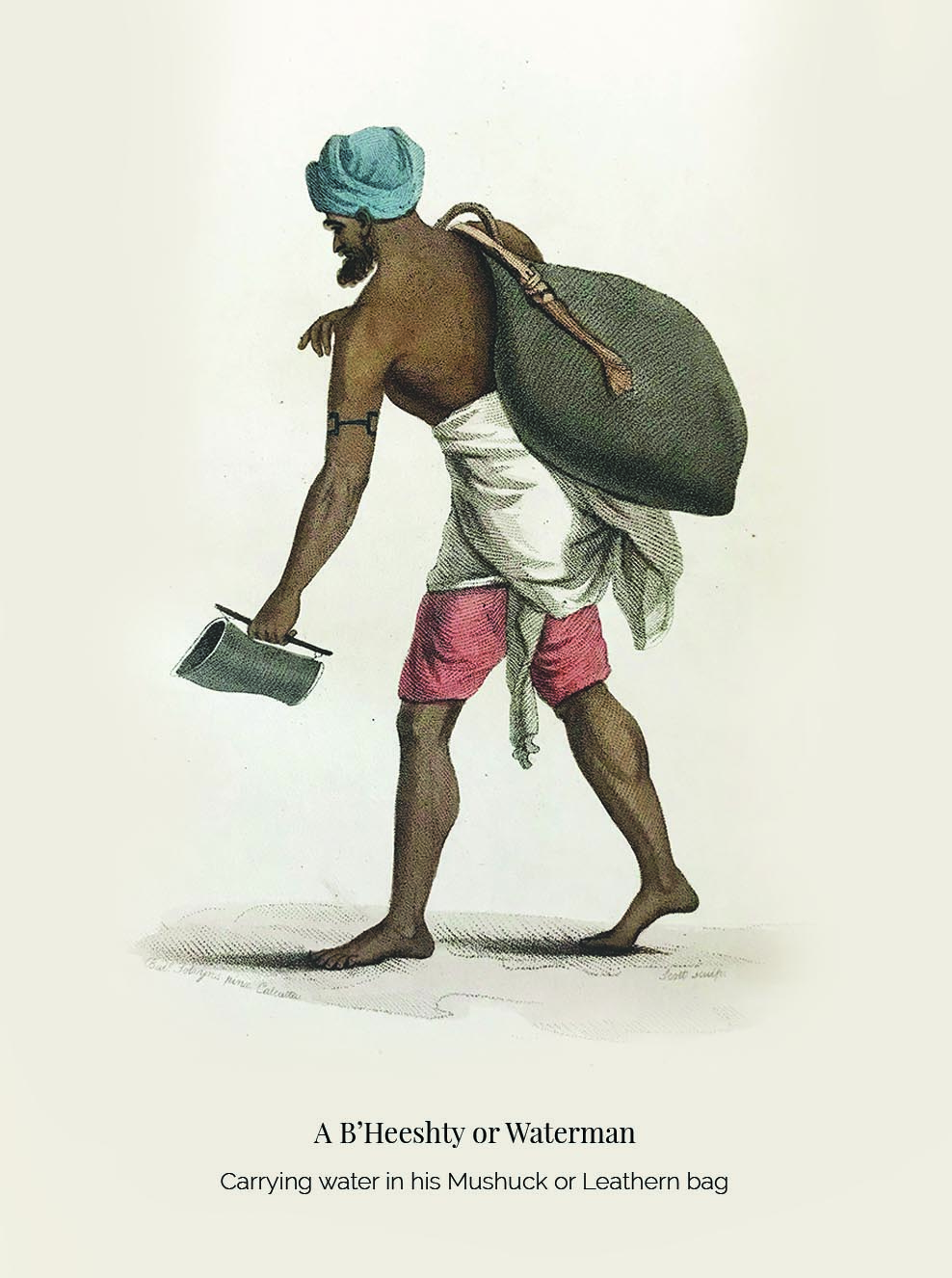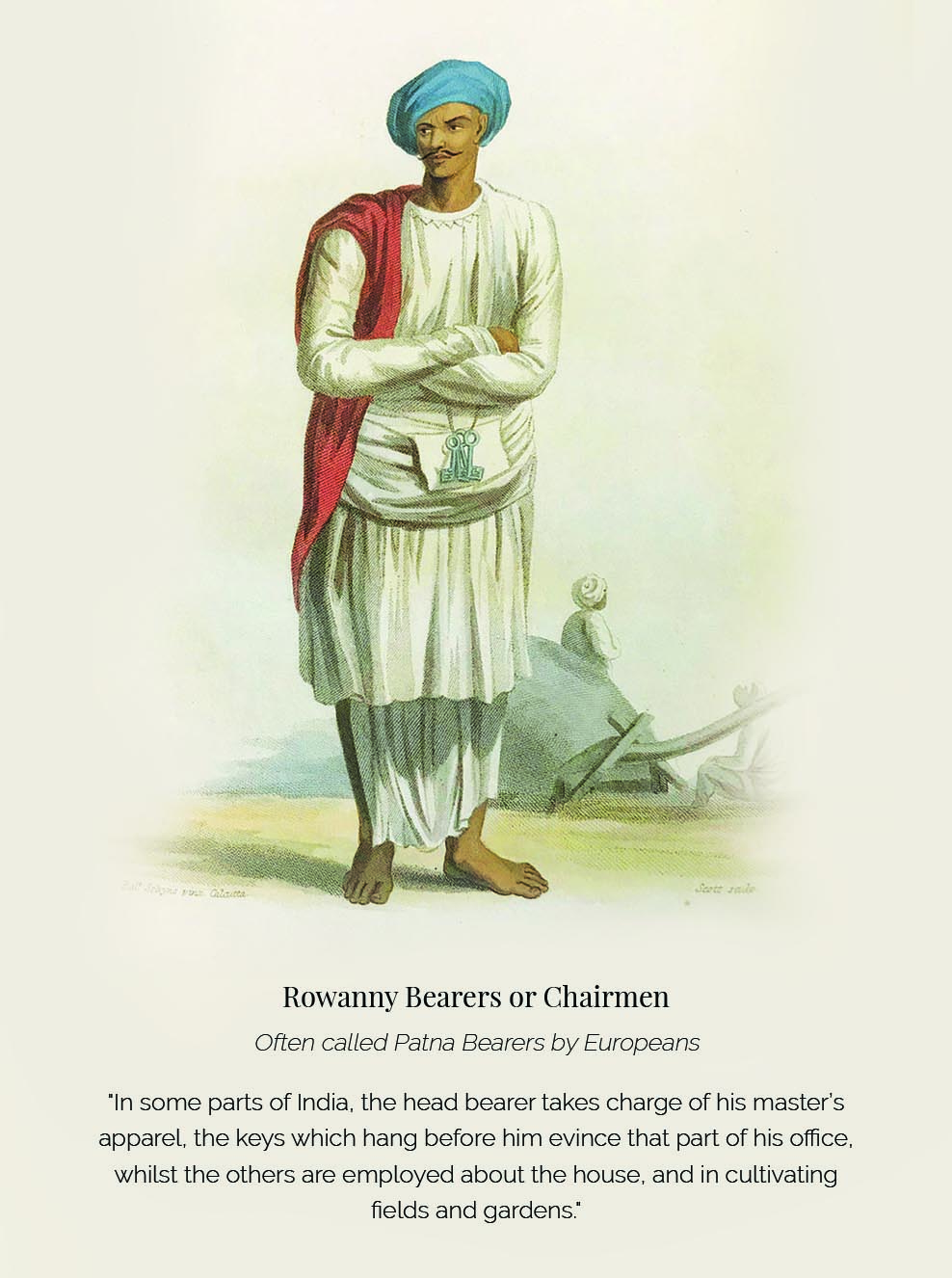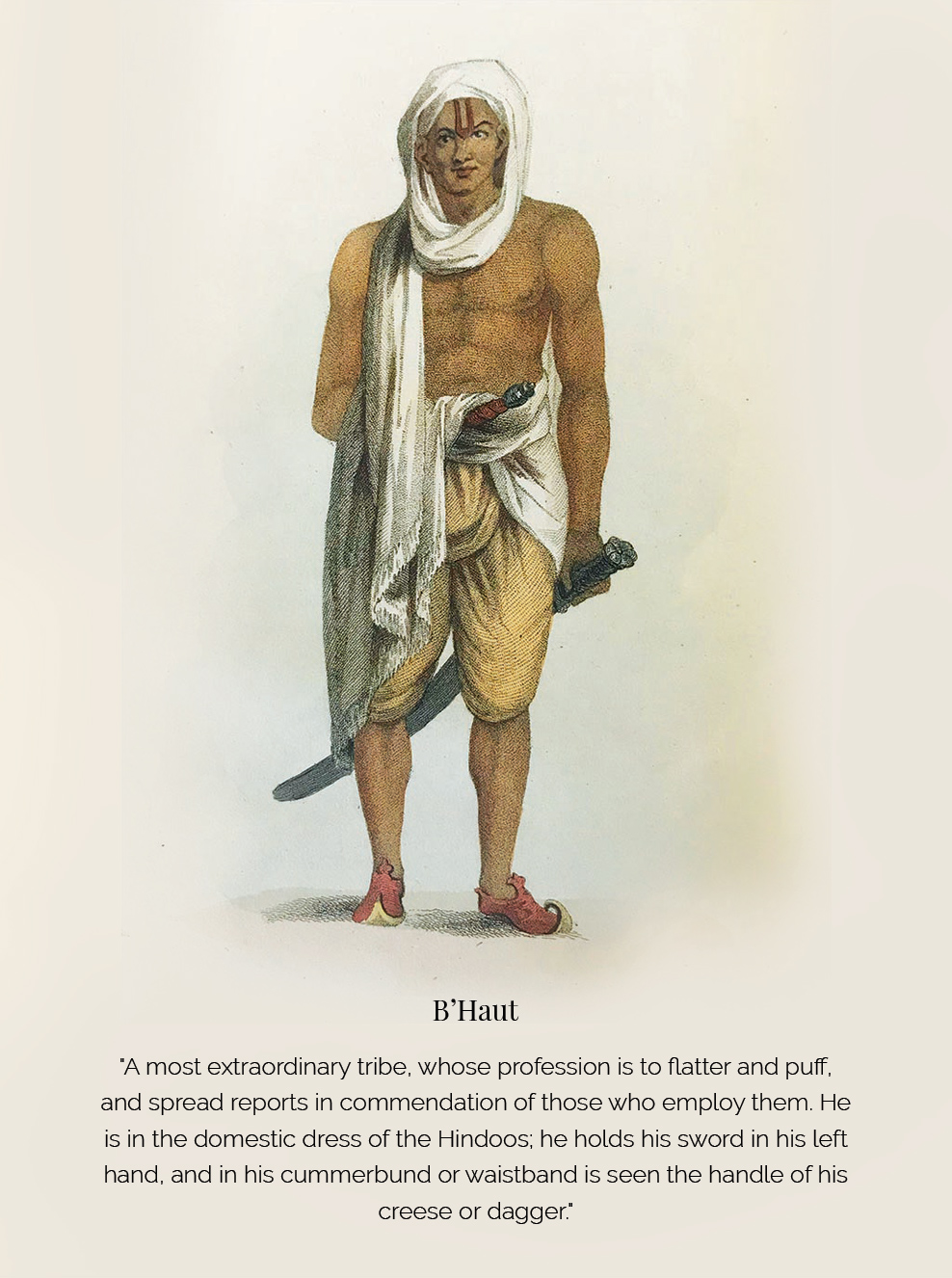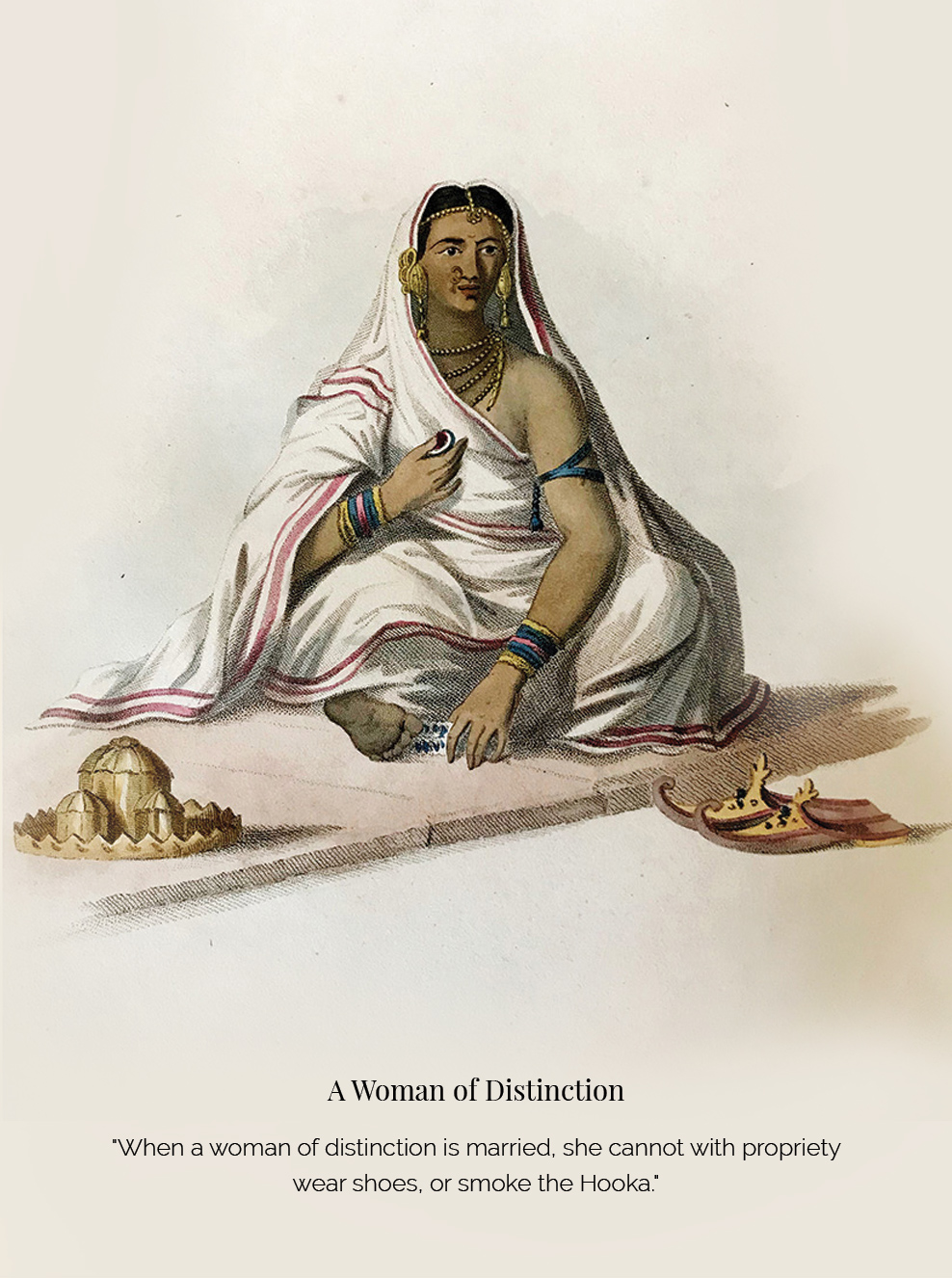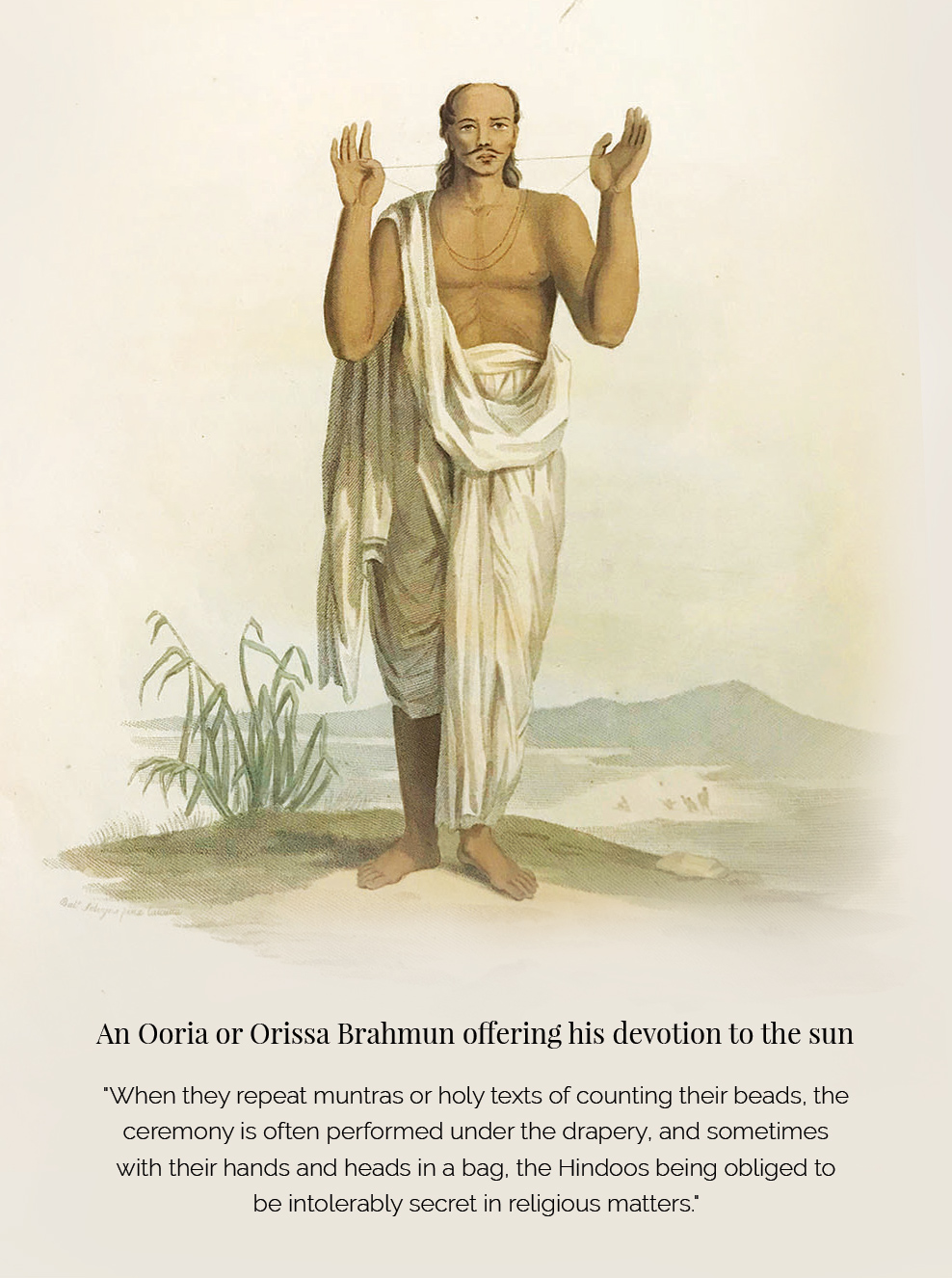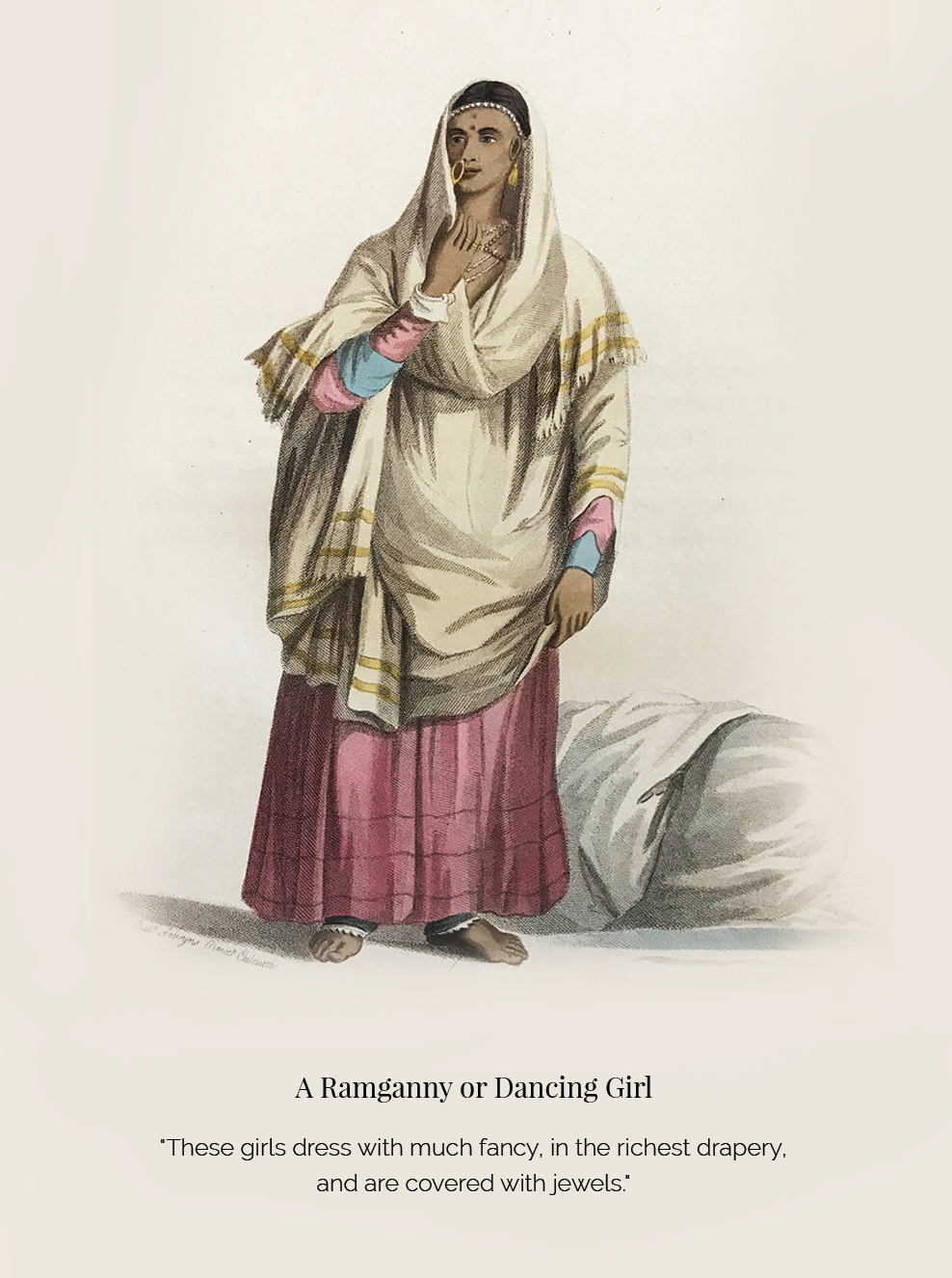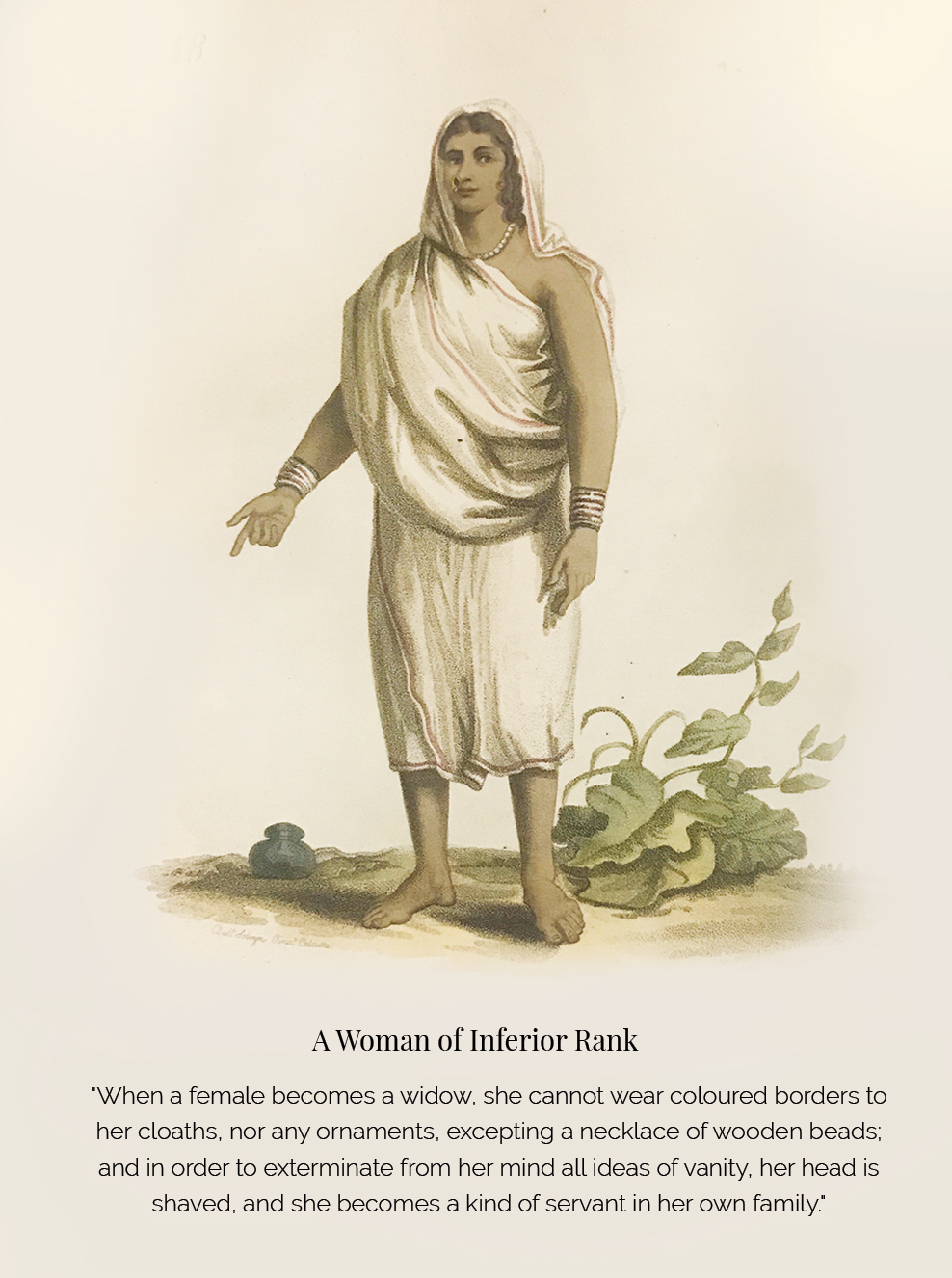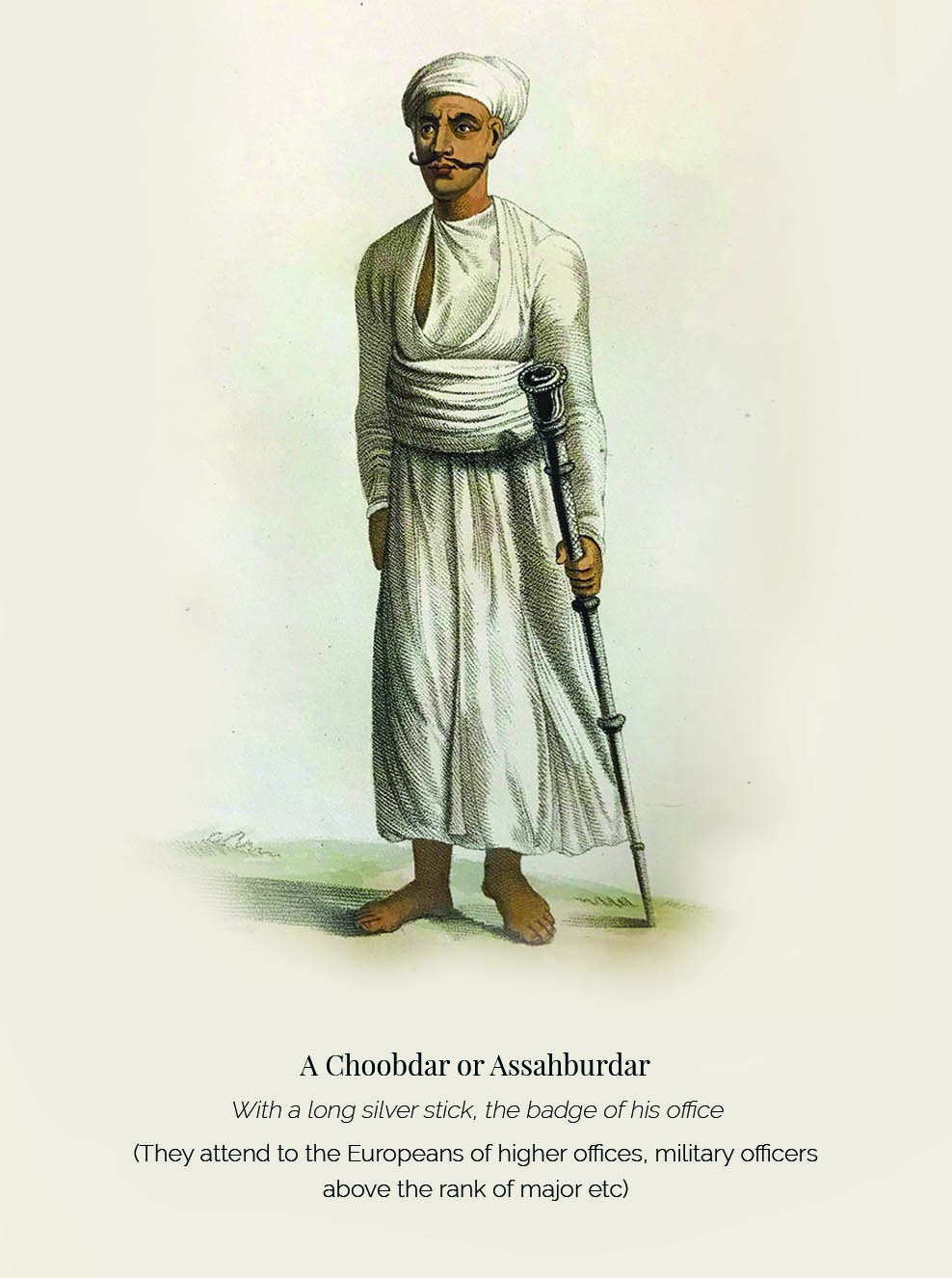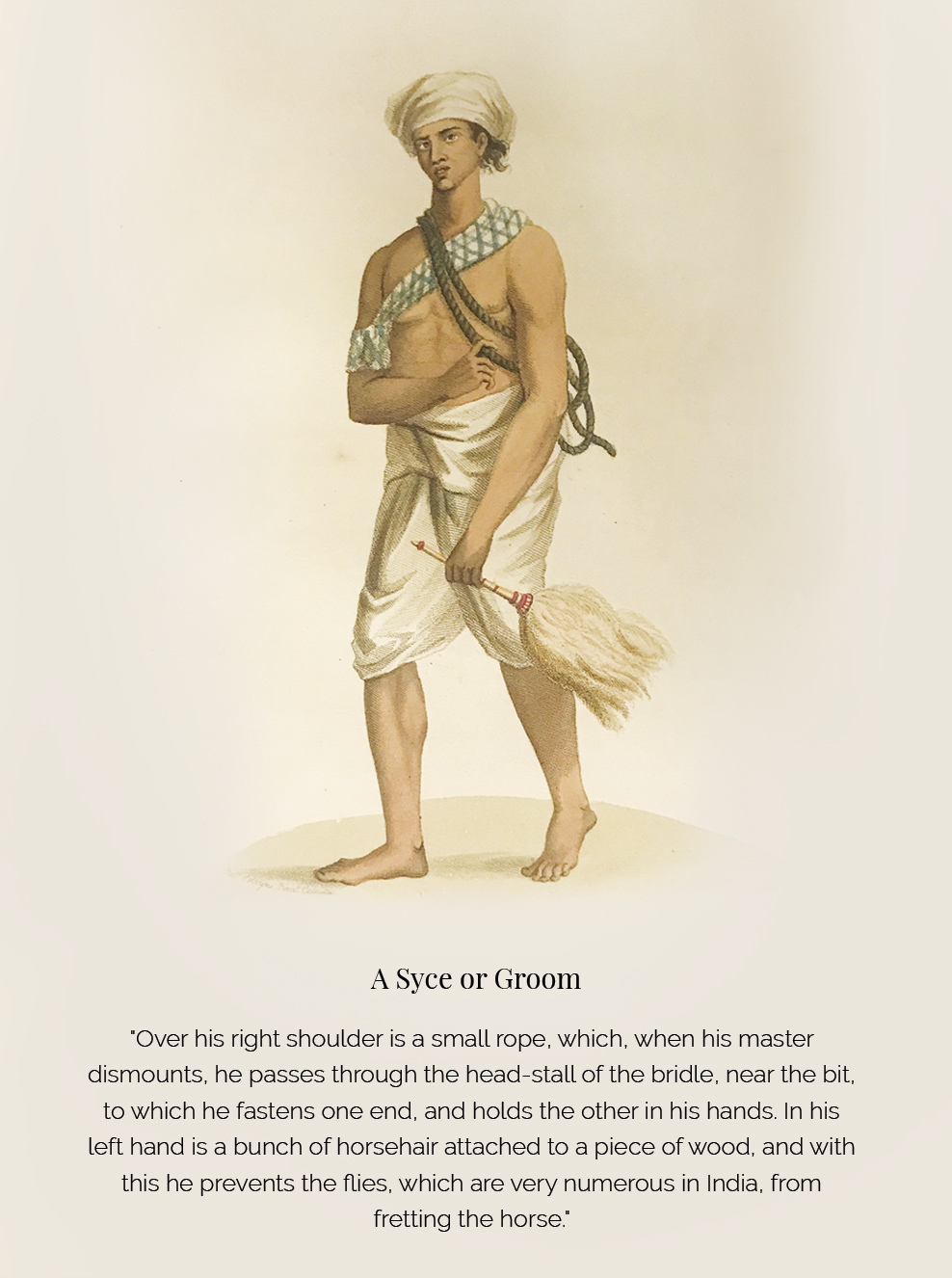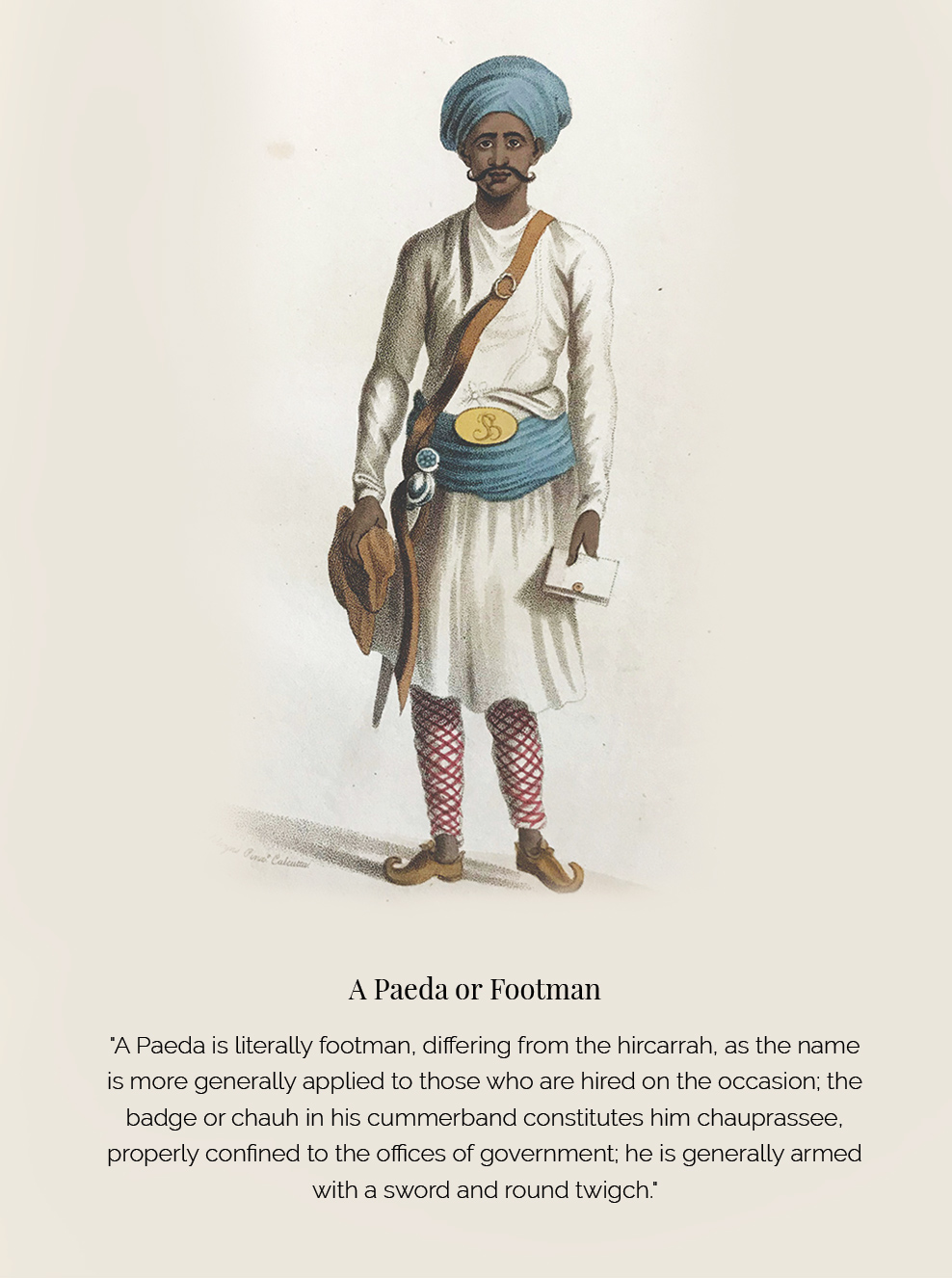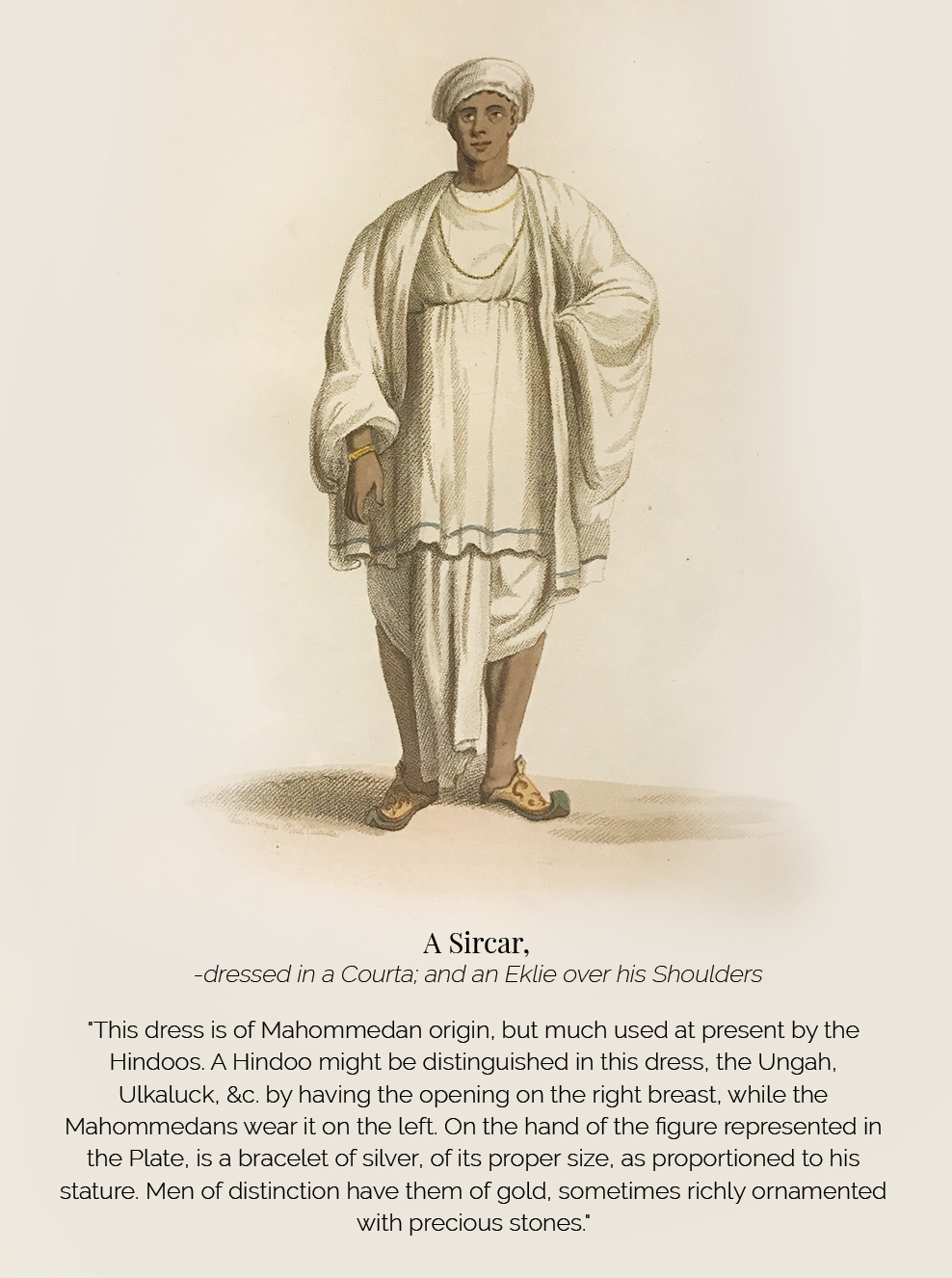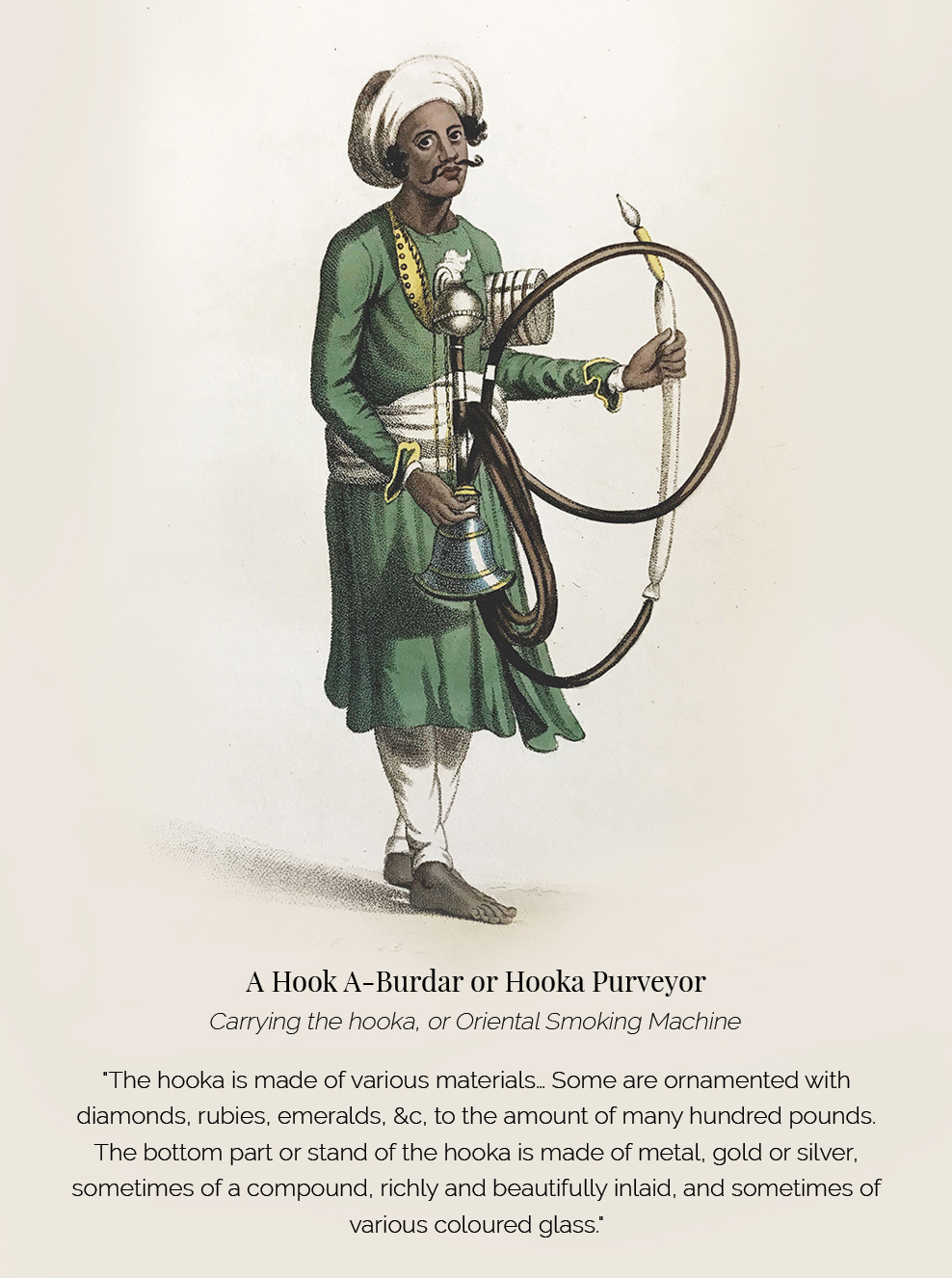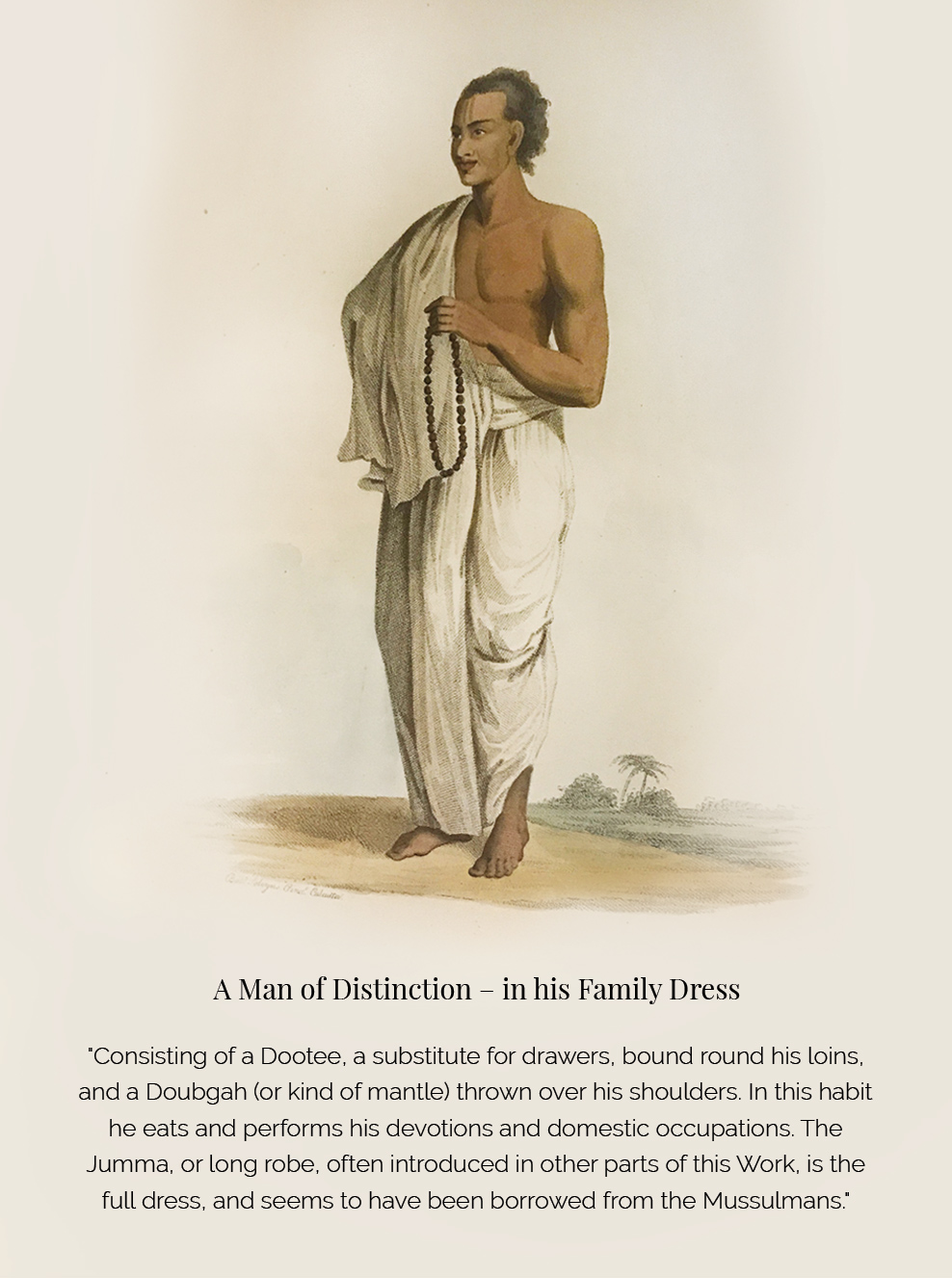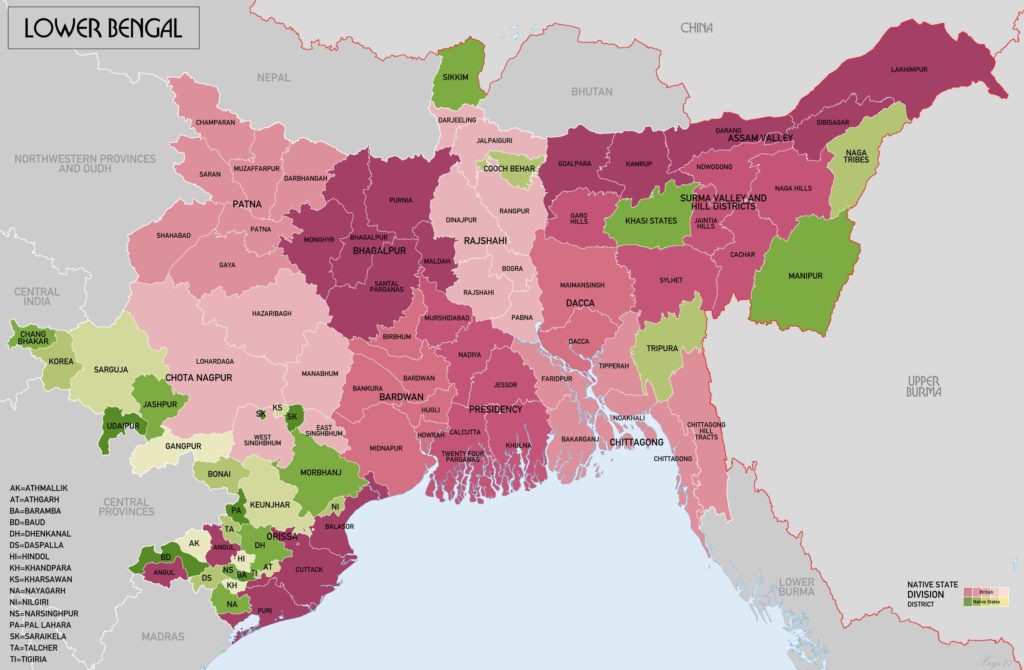All images and excerpts from the rare book Costume of Hindostan by Franz Balthazar Solvyns, 1807 © Sarmaya Arts Foundation
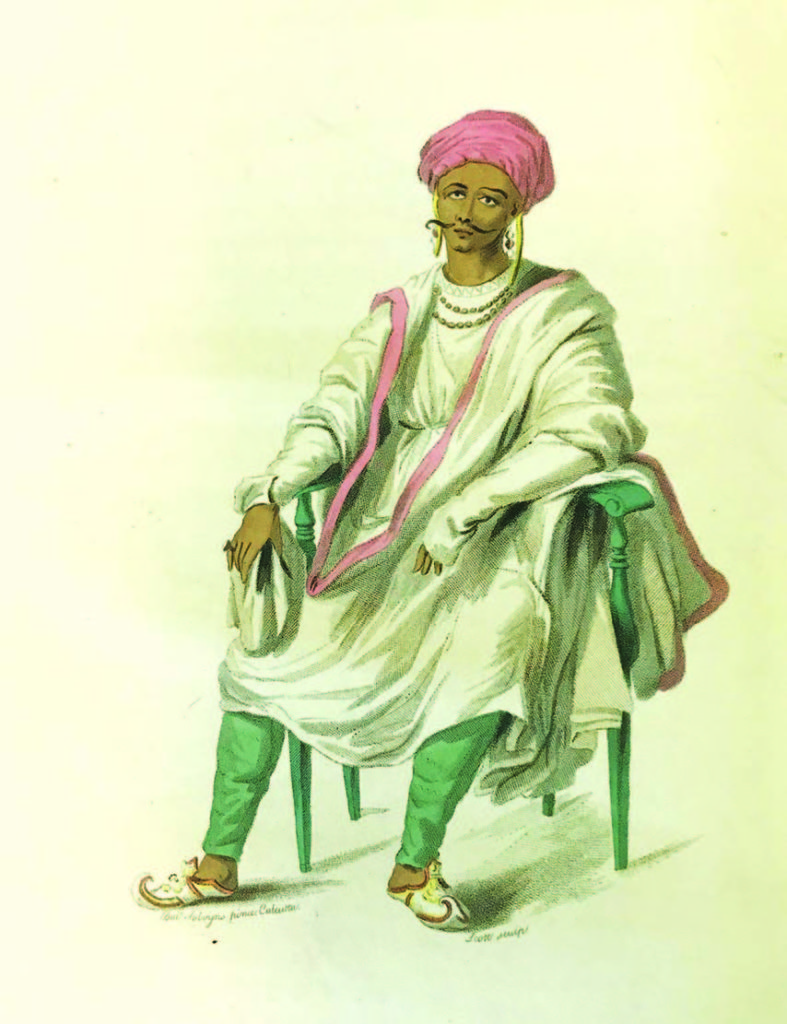
The Chittery
The Chittery is in eminence next to the Brahmun; at present, they dress generally, as represented in the plate, like Mahommedans. Princes and rajah, landlords and soldiers should be of this cast.
François Balthazar Solvyns was The Sartorialist of 18th-century Bengal. He documented the style of the common people—a messenger going about his day, a merchant setting up shop, a woman settling down to enjoy her paan—with all the art at his disposal. His work is vibrant, whimsical and useful to modern historians. But unlike Scott Schuman, Solvyns wasn’t in it just for the fashion.
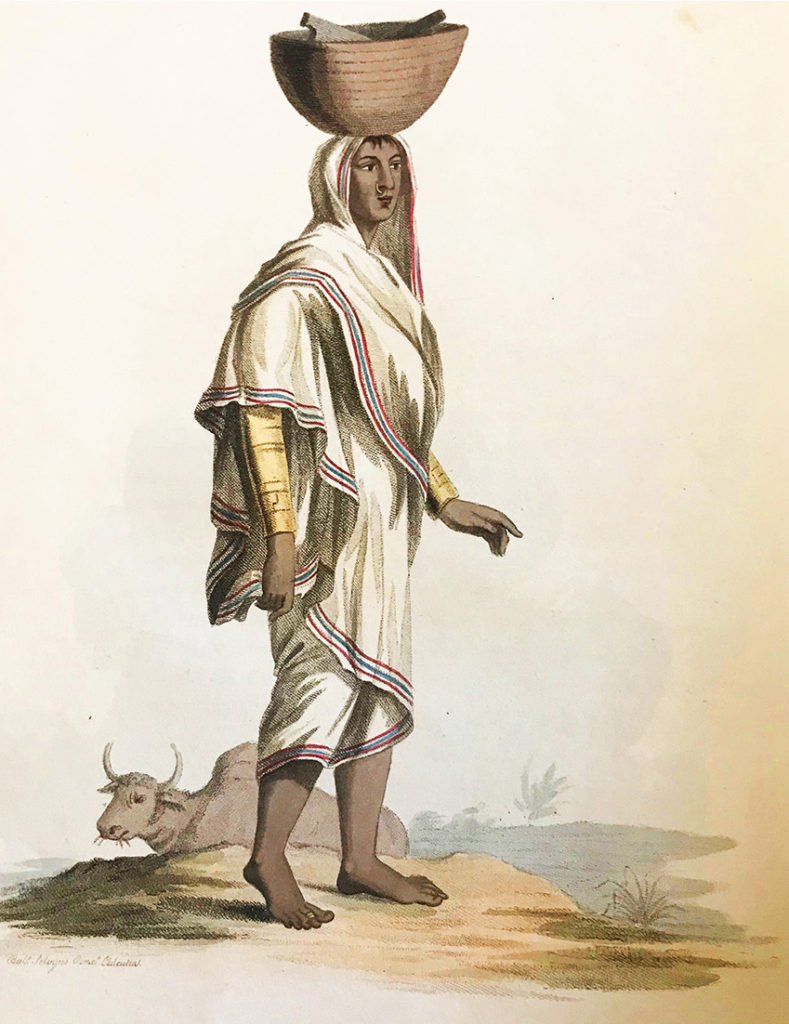
A Gwalin or Milk Woman
The brass bracelets, as represented in the Plate, are often very weighty, and serve occasionally for defense as well as ornament.
An Antwerp-born artist, Solvyns travelled to Calcutta in 1790 following the Belgian revolution in search of opportunities. A creative man, he soon found uses for his talent according to Belgian historian Jan Vandersmissen: “he is a decorator for the well-to-do class in the British factory, takes care of livening up their parties and spectacles, restoring works of art, and decorating carriages.” However, an acquaintance with Sanskrit-enthusiast Sir William Jones inspired the painter in him to pick up the brush and make studies of the people all around him. The result was a whacking big book with a whacking big title: A collection of two hundred and fifty colored etchings descriptive of the manners, customs and dresses of the Hindoos.
The work, however, turns out not to be a real success and is primarily a financial disappointment for Solvyns: as the British historian Robert L. Hardgrave states, the drawings are too monotonous to the European taste of the moment and the colors too gloomy. The themes themselves, however, appeal to the imagination, and Edward Orne, publisher in London, will later (in 1807) release a successful pirate version devoted to costumes with redesigned prints in warmer colors without the author's permission.
So Solvyns missed out on not just the recognition of his work, but also the royalties. The Costume of Hindostan was published in 1807, its text and drawings credited to ‘Balt. Solvyns, of Calcutta’ and the work was dated between 1798 and 1799. The publisher Edward Orme (his surname is variously spelled as Orne and Orme, however the rare book in the Sarmaya collection uses the latter) dedicated this tome to the chairman and directors of the East India Company. Its preface states the purpose: for the information and “amusement” of its British readers. This sets the tone for the rest of the book, whose text displays great condescension towards the natives of the subcontinent. Words like ‘primitive’ and ‘absurd’ make an appearance while describing local customs, betraying both the ignorance and latent fear of the coloniser.
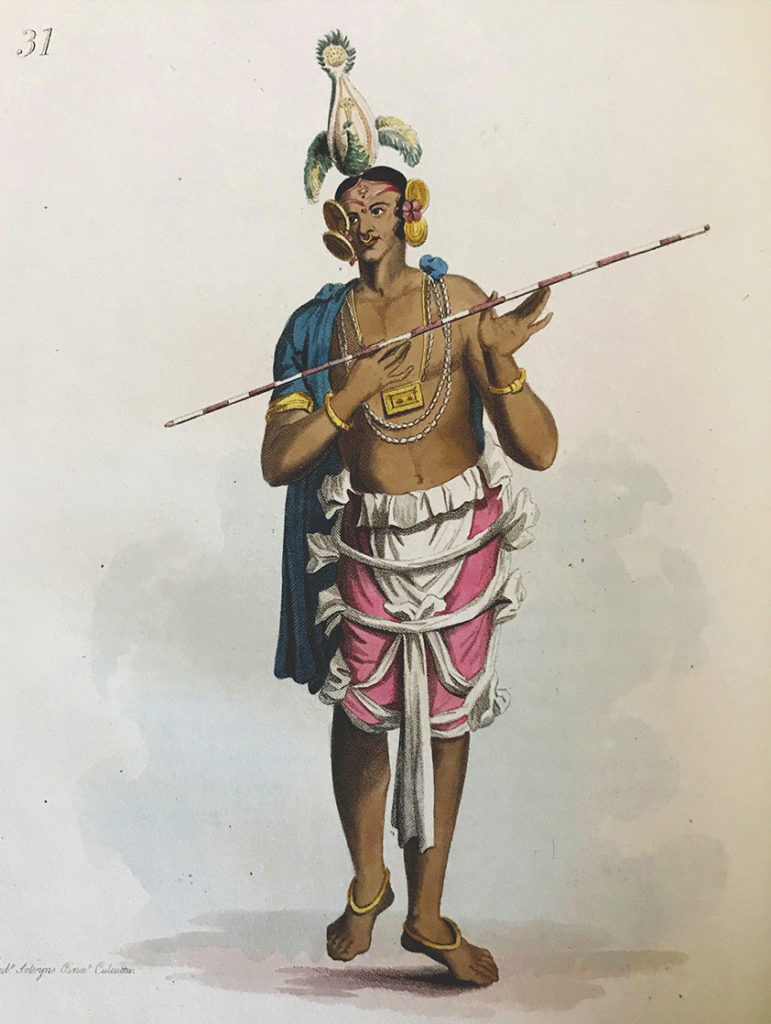
Bauluck
This is the name given to dancing boys who often perform female parts in their dramas.
At the celebration of the swinging of Krishna, and incarnation of that deity, they frequently disappear, and change their dress to personify Radica, Laletah, Bisahah, and other favourites of Krishna. One man is dressed to represent the mother of Krishna, holding in his hand a lamp of five lights, with which is performed the charm to guard Krishna from evil spirits.
Following the Battle of Plassey in 1757 and up until 1912, the East India Company governed the region known as Bengal Presidency, which was a collection of large, wealthy provinces with its administrative capital in Calcutta. If you think it was strange for a corporate entity to take on the powers of a government, you’d be right. The Company ran Bengal as a for-profit business, tampering with land rights to the point that when a drought hit the land in 1769, it triggered a series of calamities ending in The Great Famine of 1770. This is estimated to have caused the deaths of 10 million Indians. The subjects who posed for Solvyns’s project two decades later no doubt still carried the memories and scars of this horrific man-made disaster.
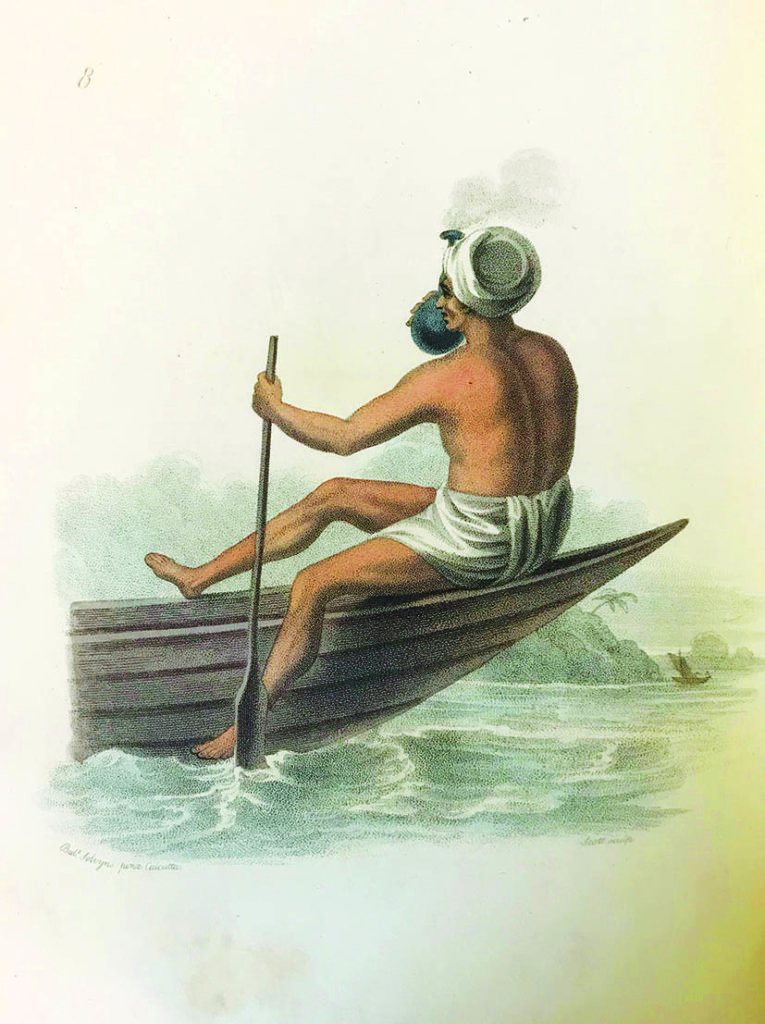
A Dandy or Boatman
The plate represents their common dress; light however as that is, they sometimes are less attired, having no turban on their head, and their lower garment considerably diminished.
But why did he undertake this project anyway? In the time before photography, artists like Solvyns were routinely employed by nations, corporates and the military to document events, journeys and people. The Belgian himself was earlier employed by the Navy to make marine paintings in exchange for free passage on trading ships. By the end of the 18th century, the East India Company was a hugely influential entity in Britain. It was wealthy and members of the British parliament were among its stock-holders—its fate was tied to the might of the empire. Naturally, then, there was curiosity among the common Britons about these people in a faraway land whose politics and culture were suddenly part of the national conversation.
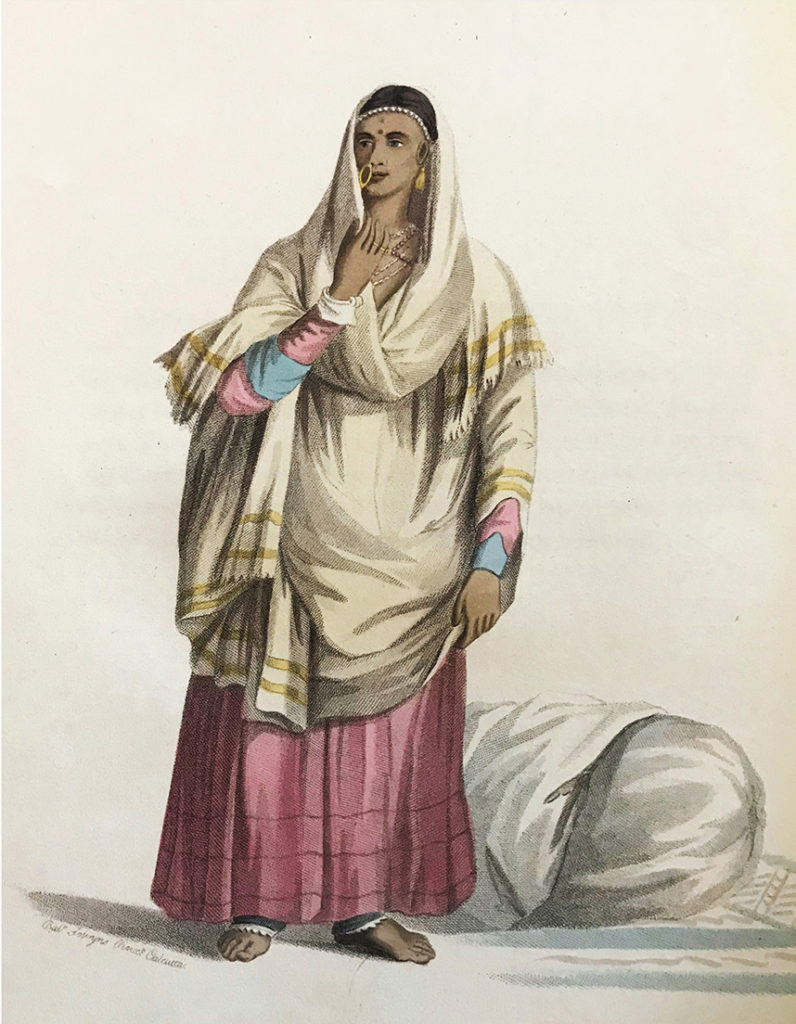
A Ramganny or Dancing Girl
These girls dress with much fancy, in the richest drapery, and are covered with jewels.
Apart from costume, Solvyns also records with precision the widespread prevalence of the caste system, which played a big role in dictating what you could wear and what you might choose to wear as a mark of supremacy. The castes are spelt phonetically: Brahmun, Chittery (Kshatriya), Byce (Vaishyas) and Soodder (Shudra). The artist also shines a light on the cruelty shown to widows in 18th-century Bengal. The area he covered, the Bengal Presidency, did constitute a big chunk of the land mass of the subcontinent, including much of present-day Punjab, Bihar, UP, Odisha, Assam (many parts of North-East India are folded in here), Myanmar and Bangladesh. Solvyns restricted his survey to the region known as Lower Bengal.
The Costume of Hindostan, part of our rare books collection, contains 60 engravings based on the art of François Balthazar Solvyns. While he didn’t get his due during his lifetime, he might have drawn some small comfort from the fact that 20th-century historians found his work useful. While his sample size was limited to the people of Bengal—who he incorrectly supposed represented all the cultures of the whole subcontinent!—the level of detail in his paintings makes for a delightful history lesson. Perhaps the most winning aspect of this work is that it gives us a glimpse of people who did not have the means to write their own history. The workers, weavers, artisans, traders and other common citizens who made sure the wheels of 18th-century society turned silently and smoothly.
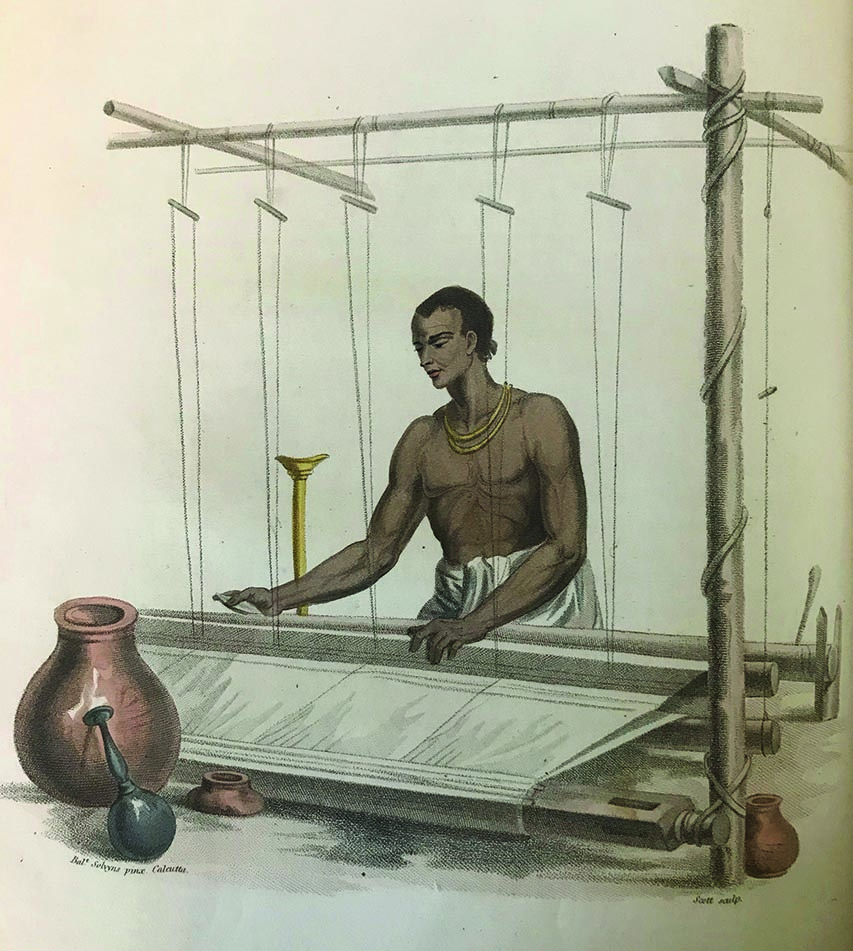
Tauntees or Weavers
With the manner of their working on the loom
The loom is rude and simple, yet with such machinery they manufacture those beautiful muslins that are in Europe so much sought after and admired. The texture of some of them is so extremely delicate that when spread between two persons the appearance is that of a mist or fog, and although a yard and a quarter wide, can be drawn through a wedding ring. The weaver generally sits on the ground and there is an excavation under the loom, in which he places his legs.
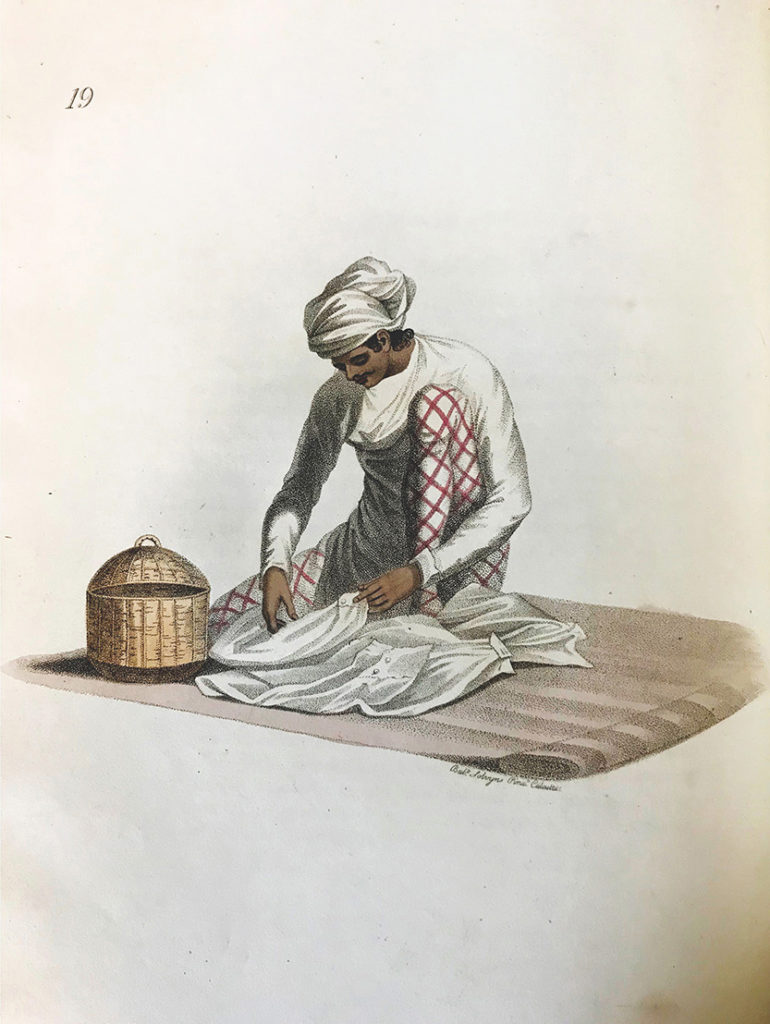
A Durzee or Taylor
Almost every family retains one or two of them in the house, as a piece of economy. They not only make the exterior dress of gentlemen, but his linen also, and are at once taylor, mantua-makers and milliners.

